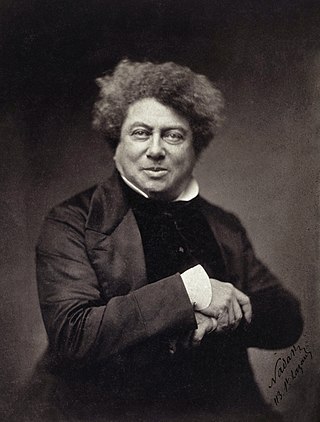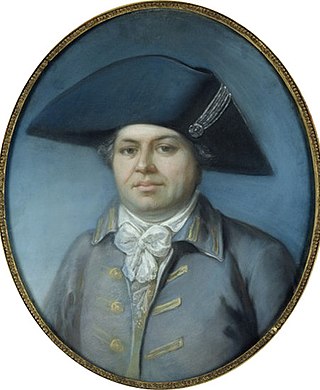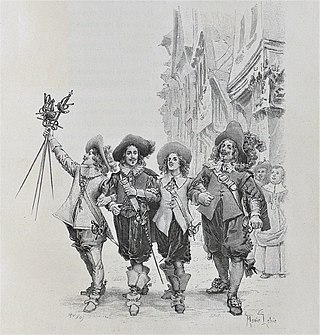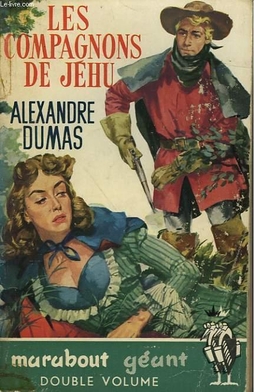Related Research Articles

The Battle of Trafalgar was a naval engagement that took place on 21 October 1805 between the British Royal Navy and the combined fleets of the French and Spanish Navies during the War of the Third Coalition of the Napoleonic Wars (1803–1815).

The Count of Monte Cristo is an adventure novel written by French author Alexandre Dumas (père) completed in 1844. It is one of the author's most popular works, along with The Three Musketeers. Like many of his novels, it was expanded from plot outlines suggested by his collaborating ghostwriter Auguste Maquet.

Alexandre Dumas, 24 July 1802 – 5 December 1870), also known as Alexandre Dumas père, was a French novelist and playwright.

Georges Cadoudal, sometimes called simply Georges, was a Breton counter-revolutionary and leader of the Chouannerie during the French Revolution. He was posthumously named a Marshal of France in 1814 by the reinstated Bourbons. Cadoudal means in Breton language "warrior returning from the fight".

The Three Musketeers is a French historical adventure novel written in 1844 by French author Alexandre Dumas. As with some of his other works, he wrote it in collaboration with ghostwriter Auguste Maquet. It is in the swashbuckler genre, which has heroic, chivalrous swordsmen who fight for justice.

Charles de Batz de Castelmore, also known as d'Artagnan and later Count d'Artagnan, was a French Musketeer who served Louis XIV as captain of the Musketeers of the Guard. He died at the siege of Maastricht in the Franco-Dutch War. A fictionalised account of his life by Gatien de Courtilz de Sandras formed the basis for the d'Artagnan Romances of Alexandre Dumas père, most famously including The Three Musketeers (1844). The heavily fictionalised version of d'Artagnan featured in Dumas' works and their subsequent screen adaptations is now far more widely known than the real historical figure.
The d'Artagnan Romances are a set of three novels by Alexandre Dumas (1802–1870), telling the story of the 17th-century musketeer d'Artagnan.

Jean Charles Emmanuel Nodier was a French author and librarian who introduced a younger generation of Romanticists to the conte fantastique, gothic literature, and vampire tales. His dream related writings influenced the later works of Gérard de Nerval.
Claude Voilier was a French teacher, journalist, translator, and a prolific author, having written over 600 short stories for various French magazines, and about 400 stories for children. In the English-speaking world, she is best known for her continuation of Enid Blyton's The Famous Five series of children's adventure novels.

Thomas-Alexandre Dumas Davy de la Pailleterie was a Creole general, from the French colony of Saint-Domingue, in Revolutionary France. Along with his French contemporary Joseph Serrant, Toussaint Louverture in Saint-Domingue and Abram Petrovich Gannibal in Imperial Russia, Thomas-Alexandre Dumas is notable as a man of African descent leading European troops as a general officer. He was the first person of color in the French military to become brigadier general, divisional general, and general-in-chief of a French army.

Auguste Maquet was a French author, best known as the chief collaborator of French novelist Alexandre Dumas, père, co-writing such works as The Count of Monte Cristo and The Three Musketeers.

Le Chevalier de Maison-Rouge was written in 1845 by Alexandre Dumas, père. It is related to a series referred to as the Marie Antoinette romances, though technically not part of that series as the characters of Joseph Balsamo and Doctor Gilbert do not appear in the novel, and many of the other series' protagonists have died by the start of this novel. The novel takes place shortly after the end of the series, following the death of Louis XVI. Set in Paris during the Reign of Terror, the novel follows the adventures of a brave young man named Maurice Lindey who unwittingly implicates himself in a Royalist plot to rescue Marie Antoinette from prison. Maurice is devoted to the Republican cause, but his infatuation with a beautiful young woman leads him into the service of the mysterious Knight of Maison-Rouge, the mastermind behind the plot.
The Two Dianas is a historical novel published in 1846–47 under the name of Alexandre Dumas but mostly or entirely written by his friend and collaborator Paul Meurice. The "two Dianas" of the title are Diane de Poitiers and her supposed daughter Diana de Castro. The novel's setting is earlier than Dumas's better known "Valois trilogy". The principal character is Gabriel, comte de Montgomery; other characters include Martin Guerre, Catherine de Médicis and Ambroise Paré. When Meurice later published a dramatisation of the novel, a letter supposedly written by Dumas was attached as a preface, stating that he had never even read the book and that Meurice was the real author. Nevertheless, it has been argued that Dumas was at least somewhat involved in its composition. According to F. W. J. Hemmings, The Two Dianas is "entirely lacking in Dumas's usual deftness of touch".

In literature, a serial is a printing or publishing format by which a single larger work, often a work of narrative fiction, is published in smaller, sequential instalments. The instalments are also known as numbers, parts, fascicules or fascicles, and may be released either as separate publications or within sequential issues of a periodical publication, such as a magazine or newspaper.

Horatio Nelson, 1st Viscount Nelson, 1st Duke of Bronté, was one of the leading British flag officers in the Royal Navy of the French Revolutionary and Napoleonic Wars, responsible for several important victories over the French and Spanish navies during a time of crisis for the country. He was widely lauded for his success, and praised for his skill and daring. After his death during the Battle of Trafalgar, he became revered as a British hero, and his fame reached new heights. Large numbers of monuments and memorials have been created in his honour, and he has continued to influence British culture and society.
The Napoleonic Wars were a defining event of the early 19th century, and inspired many works of fiction, from then until the present day.
Claude Pierre Edmond Giraud was a French actor.
Les Mousquetaires de la reine, sold in the United States as The Queen's Musketeers and in Britain as The Musketeers of the Queen, was a 1903 French short silent film by Georges Méliès.

The Countess of Salisbury is an 1836 historical adventure novel by the French writer Alexandre Dumas. It was serialised in the newly founded La Presse newspaper between July and September 1836. Dumas had been writing plays since the 1820s, but this marked his first serialised novel. In 1839 it was published as a three volume edition and a year later was published in an English translation. Walter Scott was an influence on the author's writings, and he praises him in the preface of the 1839 edition in comparison to Genlis and Cottin. It is inspired by the life of the Countess of Salisbury and her relations with Edward III of England in the fourteenth century.

The Companions of Jehu is a historical adventure novel by the French writer Alexandre Dumas first published in 1857. It is inspired by the story of the Companions of Jehu, a group of Royalist vigilantes during the French Revolution. It was also turned into a play by Dumas and Charles Gabet premiering at the Théâtre de la Gaîté on 2 July 1857.
References
- 1 2 3 Crace, John (28 May 2006). "Claude Schopp: The man who gave Dumas 40 mistresses". The Guardian . Retrieved 19 August 2008.
- ↑ French Studies: "Quebecer discovers an unpublished manuscript by Alexandre Dumas", iForum, University of Montreal, 30 September 2004, accessed 11 August 2012
- Anonymous (March 23, 2005). Novel reveals mystery. News 24.com. Retrieved March 30, 2005.
- Susan Bell (March 23, 2005). Dumas's trilogy completed as novel unearthed 135 years on. News.Scotsman.com. Retrieved March 30, 2005.